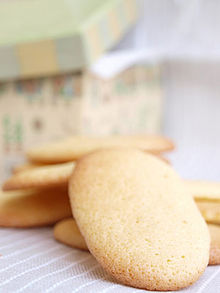
A chocolate chip cookie is a drop cookie that features chocolate chips or chocolate morsels as its distinguishing ingredient. Chocolate chip cookies are claimed to have originated in the United States in 1938, when Ruth Graves Wakefield chopped up a Nestlé semi-sweet chocolate bar and added the chopped chocolate to a cookie recipe; however, historical recipes for grated or chopped chocolate cookies exist prior to 1938 by various other authors.
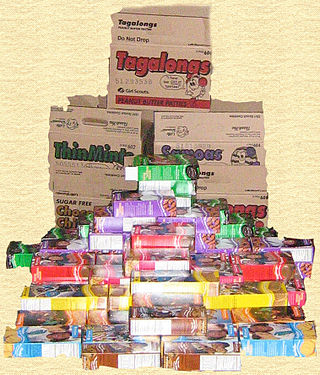
Girl Scout Cookies are cookies sold by Girl Scouts in the United States to raise funds to support Girl Scout councils and individual troops. The cookies are widely popular and are commonly sold by going door-to-door, online, through school or town fundraisers, or at "cookie booths" set up at storefronts. The program is intended to both raise money and improve the financial literacy of girls. During an average selling season, more than one million girls sell over 200 million packages of cookies and raise over $800 million. The first known sale of cookies by Girl Scouts was in 1917. Cookie sales are organized by 112 regional Girl Scout councils who select one of two national bakeries to buy cookies from.
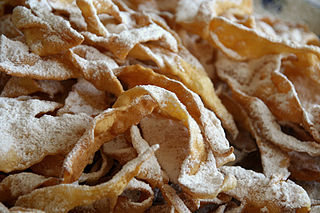
Angel wings are a traditional sweet crisp pastry made out of dough that has been shaped into thin twisted ribbons, deep-fried and sprinkled with powdered sugar. Common to many European cuisines, angel wings have been incorporated into other regional cuisines by immigrant populations. They are most commonly eaten in the period just before Lent, often during Carnival and on Fat Thursday, the last Thursday before Lent—not to be confused with "Fat Tuesday", the day before the start of Lent. There is a tradition in some countries for husbands to give angel wings to their wives on Friday the 13th in order to avoid bad luck.

Biscocho, also spelled biskotso, refers to various types of Filipino twice-baked breads, usually coated with butter and sugar, or garlic in some cases. Biscocho is most strongly associated with the versions from the province of Iloilo, although it actually exists nationwide in various forms. It is also known as biscocho duro, machacao, or matsakaw. It is also historically known as pan de caña.

Apas are very thin oblong-shaped biscuits sprinkled with sugar. They are a specialty of Quezon and the wider Southern Tagalog region; but they are also found in Cebu. They are also known as binuruhas in Sariaya. They are made with flour, milk, eggs, sugar, and butter. They are mild-flavored and are typically eaten with hot drinks.

Beef tongue is a cut of beef made of the tongue of a cow. It can be boiled, pickled, roasted or braised in sauce. It is found in many national cuisines, and is used for taco fillings in Mexico and for open-faced sandwiches in the United Kingdom. In France and Belgium it is served with Madeira sauce, while chrain is the preferred accompaniment in Ashkenazi and Eastern European cuisines. Germans make white roux with vinegar and capers, or horseradish cream, which is also popular in Polish cuisine.

Salpicon is a dish of one or more ingredients diced or minced and bound with a sauce or liquid. There are different versions found in Spanish and the broader Latin American cuisine and Filipino cuisine. A salpicon is sometimes used as stuffing.

Mamón are traditional Filipino chiffon or sponge cakes, typically baked in distinctive cupcake-like molds. In the Visayas regions, mamón are also known as torta mamón or torta. Variants of mamón include the larger loaf-like version called taisan, the rolled version called pianono, and ladyfingers known as broas. Mamón also has two very different variants that use mostly the same ingredients, the cookie-like mamón tostado and the steamed puto mamón.

A cat tongue is a small biscuit (cookie) or chocolate bar available in a number of European, Asian, and South American countries. The name comes from the fact that the biscuits are long and flat, somewhat like a cat's tongue.

Puto seco, also known as puto masa, are Filipino cookies made from ground glutinous rice, cornstarch, sugar, salt, butter, and eggs. They are characteristically white and often shaped into thick disks. They have a dry, powdery texture.

Butter cookies, also known as Danish butter cookies, are cookies originating in Denmark consisting of butter, flour, and sugar. They are similar to shortbread cookies.

Cookie butter is a food paste made primarily from speculoos cookie crumbs, fat, flour, and sugar. The ingredients are mixed until it becomes spreadable on a sandwich. In countries like Belgium, the Netherlands, and France, it is a common alternative to nut butter and chocolate spreads.

Barquillo is a crispy rolled wafer pastry originating in Spain. It is made from the basic cookie ingredients of flour, sugar, egg whites and butter rolled out thinly and then shaped into a hollow cylinder or a cone. It was traditionally sold by roadside vendors known as barquilleros who carried a characteristic red roulette tin. It was introduced to Latin America and the Philippines during colonial times. In Spain and former Spanish colonies, barquillos are commonly regarded as a type of Christmas cookie. It is also popular during various fiestas. It spread to neighboring countries and today is extremely popular in East and Southeast Asian countries.
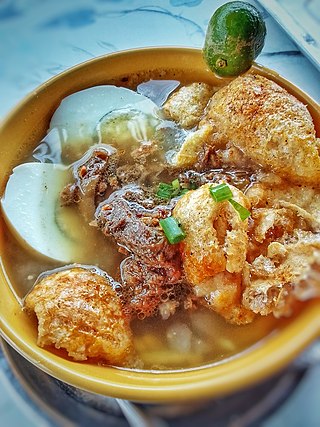
Kinalas is a Bicol dish consisting of noodles (pancit) garnished by scraped meat from pork or beef's head and other parts, enhanced with a thick deep-brown sauce coming from the brains of a cow or pig. The dish is further flavored with spices and served in hot broth. Boiled egg added is optional.

Ube crinkles, also known as purple yam crinkles, are Filipino cookies made from purple yam, flour, eggs, baking powder, butter, and sugar. They are characteristically deep purple in color and are typically rolled in powdered sugar or glazed. They have a crunchy exterior and a soft chewy center.

Camachile cookies, also known as quinamunsil, are Filipino ladyfinger cookies that are characteristically shaped like the fruits of the camachile tree. They are traditionally eaten with hot drinks for breakfast or merienda.
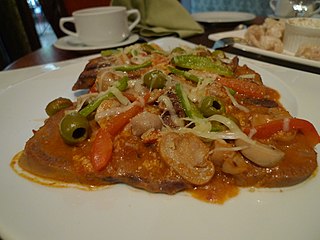
Lengua estofado, sometimes known as lengua estofada or simply lengua, is a Filipino dish consisting of braised beef tongue in a sweet sauce with saba bananas, potatoes, or mushrooms. It originates from the similar Spanish and Latin American dish estofado de lengua but differs significantly in the ingredients. The dish is prominent in the regional cuisines of the Kapampangan, Ilonggo, and Negrense people. It is usually prepared for Christmas dinner and other special occasions.
